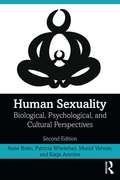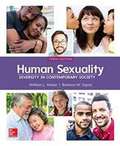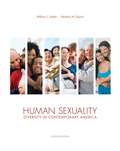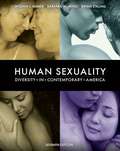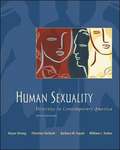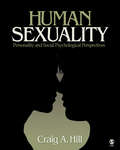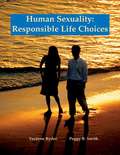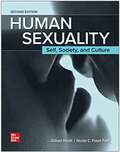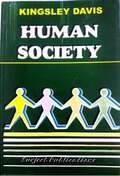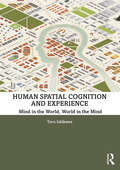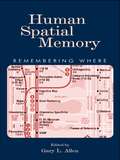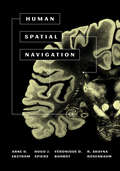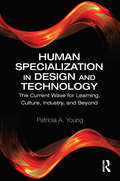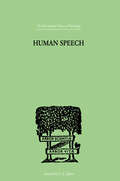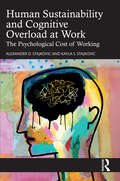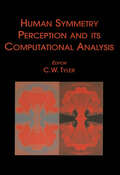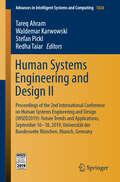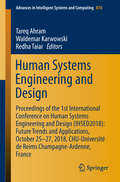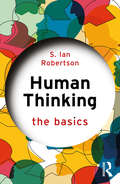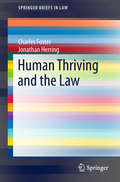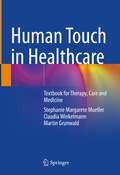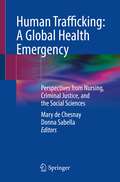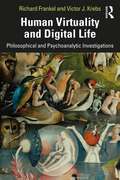- Table View
- List View
Human Sexuality: Biological, Psychological, and Cultural Perspectives
by Anne Bolin Patricia Whelehan Muriel Vernon Katja AntoineThis groundbreaking second edition of Human Sexuality continues its broad and interdisciplinary goal of providing readers with a comprehensive overview on sexuality as a core part of our individual identities and social lives. Edited by anthropological experts on the subject, this unique textbook integrates evolutionary and cultural aspects to provide a fully interdisciplinary approach to human sexuality that is rare in this area of scholarship. Fully updated throughout in line with developments in the field, this second edition includes fresh material exploring new sexual identities, sexual violence and consent, Internet pornography, conversion therapy, polyamory, and much more. In addition to providing a rich array of photographs, illustrations, tables, and a glossary of terms, this textbook explores: pregnancy and childbirth as a bio-cultural experience life-course issues related to gender identity, sexual orientations, behaviors, and lifestyles socioeconomic, political, historical, and ecological influences on sexual behavior early childhood sexuality, puberty, and adolescence birth control, fertility, conception, and sexual differentiation HIV infection, AIDS, AIDS globalization, and sex work. Utilizing viewpoints across cultural and national boundaries and taking into account the evolution of human anatomy, sexual behavior, attitudes, and beliefs across the globe, Human Sexuality, Second Edition, remains an essential text for educators and students who wish to understand human sexuality in all of its richness and complexity.
Human Sexuality: Diversity In Contemporary Society
by Barbara W. Sayad William L YarberHuman Sexuality: Diversity in Contemporary Society continues to be a pioneering text in many ways. The sexual affirmation approach encourages students to become proactive in and about their own sexual well-being and includes an emphasis on the importance of embracing intimacy, pleasuring, and mutual satisfaction in sexual expression. It also strives to represent the contemporary, diverse society that students encounter inside and outside the classroom. <P><p>And with McGraw-Hill Education Connect for Human Sexuality, students embark on a personalized digital learning program, which allows them to study more effectively and efficiently. Each chapter contains multiple Think About It features that prompt students to think critically about topics in sexuality such as am I normal, the science of love, hooking up, what behaviors constitute having had sex, orgasm and pleasure, and how college students indicate and interpret consent to have sex. The Practically Speaking feature asks students to examine their own values and the ways they express their sexuality. Topics include sexual communication, effective condom use, having sex again after sexual assault, and a glossary on sex, gender, and gender variation terms. These features help students apply the concepts presented in the book to their own lives.
Human Sexuality: Diversity in Contemporary America (8th Edition)
by Bryan Strong William Yarber Barbara SayadHuman Sexuality: Diversity in Contemporary America presents a forward thinking, open approach to Human Sexuality for today's student. The new lead authors, Bill Yarber and Barbara Sayad, continue to bring their research experience to the book while maintaining the engaging writing style that original author Bryan Strong brought to this best-selling text for years. The first text to achieve a full integration of cutting-edge research with a contemporary "sex-positive" approach, it also strives to represent the modern, diverse world that students encounter outside the classroom. Both within the text itself and throughout the exemplary art and photo program, the focus is on inclusion. Human Sexuality has been lauded by students and instructors alike for providing the most integrated and non-judgmental view of sexual orientation available. The eighth edition maintains these themes while adding a new contemporary design, streamlined format and significant content and feature revisions and updates.
Human Sexuality: Diversity in Contemporary America (Seventh Edition)
by Bryan Strong William L. Yarber Barbara J. SayadHuman Sexuality: Diversity in Contemporary America presents a forward thinking, open approach to Human Sexuality for today's student. The new lead authors, Bill Yarber and Barbara Sayad, continue to bring their research experience to the book while maintaining the engaging writing style that original author Bryan Strong brought to this best-selling text for years. The first text to achieve a full integration of cutting-edge research with a contemporary"sex-positive"approach, it also strives to represent the modern, diverse world that students encounter outside the classroom. Both within the text itself and throughout the exemplary art and photo program, the focus is on inclusion. Human Sexuality has been lauded by students and instructors alike for providing the most integrated and non-judgmental view of sexual orientation available. The seventh edition maintains these themes while adding a new contemporary design, streamlined format and significant content and feature revisions and updates.
Human Sexuality: Diversity in Contemporary America 5th ed.
by Bryan Strong Christine Devault Barbara W. Sayad William L. YarberA non-judgmental introduction to human sexuality that features integration of ethnic, cultural, gender, and sexual orientation differences and similarities.
Human Sexuality: Personality and Social Psychological Perspectives
by Craig A. Hill"Although intended as a textbook, this accessible book could as well serve in an academic collection as a useful source of background material for a variety of readers." —CHOICE"Craig Hill's new text is a welcome addition to the textbooks available for undergraduate courses on human sexuality. It goes beyond the standard topics found in many books and seriously integrates social psychological research and theory on human sexuality. This book is just the type of serious treatment of psychological aspects of human sexuality that I have been seeking for some time for my course."—Irene Hanson Frieze, Professor of Psychology, University of PittsburghHuman Sexuality: Personality and Social Psychological Perspectives presents the topics typically covered in human sexuality courses, rooting the presentation in a strong psychological perspective. Author Craig Hill focuses on personality and social psychological theory to provide students with a conceptual understanding of the psychological factors involved in sexuality, and he encourages students to build upon that foundation by challenging them to think critically about the material in various ways. He also emphasizes the scientific investigation of sexuality, offering a solid review of the research literature.Key FeaturesFocuses predominantly on the psychological aspects of sexuality: The topics covered and the organization of the book are ideally suited for instructors who wish to emphasize psychological factors involved in sexuality. Stresses the symbiotic relationship between research and theory: The book provides a more accurate and complete understanding of the way in which science generates sound evidence that informs theories pertaining to sexuality and how those theories, in turn, inform further inquiry.Presents real-life examples: Personal anecdotes enable students to relate concepts and information to the lives of real people and to their own lives, making the information clearer and more meaningful to them.Integrates cultural diversity throughout: Race, ethnicity, and sexual orientation are considered in the topics covered and the examples employed.Helps develop critical thinking and analytic abilities: Analyze This: Looking at Different Perspectives; An Opportunity for Self-Reflection; and An Eye Toward Research boxes as well as end-of-chapter questions and caption questions allow students to delve further into the material, allowing them to think critically about current topics and their own lives.Intended AudienceThis is an excellent core text for both undergraduate and graduate courses on Human Sexuality particulary those offered in departments of psychology.Supplementary MaterialAn Instructor's Resource CD provides PowerPoint presentations; chapter study material; classroom handouts; and suggestions for course projects, discussion questions, and internet exercises. Also included is a Computerized Test Bank with multiple-choice, true/false, and essay questions that allows for easy test creationA Student Study Web Site provides e-flashcards, Internet exercises and resources, self quizzes, and links to SAGE journal articles and video clips. Also available is a link to the author's blog where students can respond to comments posted by the author and other students using the text. Go to www.sagepub.com/hillhsstudy to view the site.
Human Sexuality: Responsible Life Choices
by Verdene Ryder Peggy B. SmithProvides teenage readers with basic information about sexual development and reproductive health. Chapters explain the sexual decision-making process and examine the outcomes and risks of sexual activity. Annotation c. by Book News, Inc., Portland, OR.
Human Sexuality: Self, Society And Culture
by Nicole Polen-Petit Gilbert H. HerdtWith a thought-provoking appraisal of the human sexual experience, Human Sexuality: Self, Society, and Culture supports thinking critically about the contexts that shape sexuality and further highlights the role of sexuality in society and culture. Human Sexuality fosters an atmosphere where students can safely ask questions about what they are learning or about their personal experiences. With Human Sexuality, the hope and goal is to empower students and inspire a lifelong appreciations of their own sexuality and the role of sexuality in their community, culture, and society.
Human Society
by Kingsley Davis"Human Society" by Kingsley Davis delves deeply into the theoretical underpinnings of social systems, exploring their universal traits and diverse manifestations across cultures. Davis underscores the pivotal role of culture in shaping human societies, distinguishing them from non-human counterparts. Through a meticulous integration of ideas from sociology, social anthropology, and social psychology, the book endeavors to construct a coherent framework for understanding the complexities and variations inherent in human social organization. With a comprehensive array of references and contributions from diverse disciplines, Davis strives to synthesize advanced theories, offering a nuanced perspective on the dynamics of societal structures. In essence, "Human Society" serves as a thorough theoretical exploration, elucidating the mechanisms that govern human societies while highlighting their intricate interplay with cultural influences.
Human Spatial Cognition and Experience: Mind in the World, World in the Mind
by Toru IshikawaThis book offers students an introduction to human spatial cognition and experience and is designed for graduate and advanced undergraduate students who are interested in the study of maps in the head and the psychology of space. We live in space and space surrounds us. We interact with space all the time, consciously or unconsciously, and make decisions and actions based on our perceptions of that space. Have you ever wondered how some people navigate perfectly using maps in their heads while other people get lost even with a physical map? What do you mean when you say you have a poor "sense of direction"? How do we know where we are? How do we use and represent information about space? This book clarifies that our knowledge and feelings emerge as a consequence of our interactions with the surrounding space, and show that the knowledge and feelings direct, guide, or limit our spatial behavior and experience. Space matters, or more specifically space we perceive matters. Research into spatial cognition and experience, asking fundamental questions about how and why space and spatiality matters to humans, has thus attracted attention. It is no coincidence that the 2014 Nobel Prize in Physiology or Medicine was awarded for research into a positioning system in the brain or "inner GPS" and that spatial information and technology are recognized as an important social infrastructure in recent years. This is the first book aimed at graduate and advanced undergraduate students pursuing this fascinating area of research. The content introduces the reader to the field of spatial cognition and experience with a series of chapters covering theoretical, empirical, and practical issues, including cognitive maps, spatial orientation, spatial ability and thinking, geospatial information, navigation assistance, and environmental aesthetics.
Human Spatial Memory: Remembering Where
by Gary L. AllenThe chapters in Human Spatial Memory: Remembering Where present a fascinating picture of an everyday aspect of mental life that is as intriguing to people outside of academia as it is to scientists studying human cognition and behavior. The questions are as old as the study of mind itself: How do we remember where objects are located? How do we remember where we are in relation to other places? What is the origin and developmental course of spatial memory? What neural structures are involved in remembering where? How do we come to understand scaled-down versions of places as symbolic representations of actual places? Although the questions are old, some of the answers-in-progress are new, thanks to some innovative theorizing, solid experimental work, and revealing applications of new technologies, such as virtual environments and brain imaging techniques. This volume includes a variety of theoretical, empirical, and methodological advances that invite readers to make their own novel connections between theory and research. Scholars who study spatial cognition can benefit from examining the latest from well-established experts, as well as milestone contributions from early-career researchers. This combination provides the reader with a sense of past, present, and future in terms of spatial memory research. Just as important, however, is the value of the volume as a touchstone resource for researchers who study perception, memory, or cognition but who are not concerned primarily with the spatial domain. All readers may find the fact that this volume violates the trend toward an ever-narrowing specialization refreshing. Chapters from cognitive psychologists are alongside chapters by developmentalists and neuroscientists; results from field studies are just pages away from those based on fMRI during observation of virtual displays. Thus, the book invites integrative examination across disciplines, research areas, and methodological approaches.
Human Spatial Navigation
by Arne D. Ekstrom Hugo J. Spiers Véronique D. Bohbot R. Shayna RosenbaumThe first book to comprehensively explore the cognitive foundations of human spatial navigationHumans possess a range of navigation and orientation abilities, from the ordinary to the extraordinary. All of us must move from one location to the next, following habitual routes and avoiding getting lost. While there is more to learn about how the brain underlies our ability to navigate, neuroscience and psychology have begun to converge on some important answers. In Human Spatial Navigation, four leading expertstackle fundamental and unique issues to produce the first book-length investigation into this subject. Opening with the vivid story of Puluwat sailors who navigate in the open ocean with no mechanical aids, the authors begin by dissecting the behavioral basis of human spatial navigation. They then focus on its neural basis, describing neural recordings, brain imaging experiments, and patient studies. Recent advances give unprecedented insights into what is known about the cognitive map and the neural systems that facilitate navigation. The authors discuss how aging and diseases can impede navigation, and they introduce cutting-edge network models that show how the brain can act as a highly integrated system underlying spatial navigation. Throughout, the authors touch on fascinating examples of able navigators, from the Inuit of northern Canada to London taxi drivers, and they provide a critical lens into previous navigation research, which has primarily focused on other species, such as rodents. An ideal book for students and researchers seeking an accessible introduction to this important topic, Human Spatial Navigation offers a rich look into spatial memory and the neuroscientific foundations for how we make our way in the world.
Human Specialization in Design and Technology: The Current Wave for Learning, Culture, Industry, and Beyond
by Patricia A. YoungHuman Specialization in Design and Technology explores emerging trends in learning and training—standardization, personalization, customization, and specialization—with a unique focus on innovations specific to human needs and conditions. Analyzing evidence from current academic research as well as the popular press, this concise volume defines and examines the trajectory of instructional design and technologies toward more human-centered and specialized products, services, processes, environments, and systems. Examples from education, healthcare, business, and other sectors offer real-world demonstrations for scholars and graduate students of educational technology, instructional design, and business development. The book features insights into the future of professors, public schools, equity and access, extended technologies, open educational resources, and more, concluding with a set of concrete solutions.
Human Speech: Some ObserVATIONS, EXPERIMENTS, AND CONCLUSIONS AS TO THE NATURE,
by Paget, RichardFirst published in 1999. Routledge is an imprint of Taylor & Francis, an informa company.
Human Sustainability and Cognitive Overload at Work: The Psychological Cost of Working
by Alexander D. Stajkovic Kayla S. StajkovicThis innovative book considers the cost of cognitive overload and psychological distress on human sustainability, and suggests ways to prevent employees from becoming a psychologically depleted workforce.Employee attentional processing capacity is maxed out, and psychological distress is at an all-time high. Alexander D. Stajkovic and Kayla S. Stajkovic explain how human cognitive ‘broadband’ is at the hunter-gatherer level and changes at an evolutionary snail’s pace. Yet the amount of information necessary to make a living now is incomparable to then, and the current relationship between workers and organizations is unsustainable. The authors discuss causes, processes, and consequences of human unsustainability at work, as well as suggesting remedies for personal change, leadership practice, and policy development. They frame efforts toward furthering human sustainability as a grand challenge that tackles a chronic problem at a societal level with consequences that have ripple effects into other spheres of life. Drawing from multiple disciplines and data sources, the book offers a theory-driven, evidence-based, and meaningful way to better understanding employee cognitive overload and psychological distress in organizations across the globe, and improve work lives going forward.Human Sustainability and Cognitive Overload at Work is a useful resource for students and scholars of business, management, leadership, organizational and work psychology, and organizational studies. The practical insights will also help managers, policy makers, policy analysists, consultants, and all those with an interest in the psychological cost of working.The Open Access version of this book, available at www.taylorfrancis.com, has been made available under a Creative Commons Attribution-Non Commercial-No Derivatives (CC-BY-NC-ND) 4.0 license.
Human Symmetry Perception and Its Computational Analysis
by Christopher W. TylerSymmetry is a fundamental principle of broad concern from the physical sciences to art and design. Much of its significance derives from the perceptual appeal of symmetry to the human brain, as testified by its universal inclusion in those icons of decor--oriental rugs. Although there have been many books on physical symmetry, none have addressed the issue of human symmetry perception. This comprehensive collection provides a wide range of approaches to the study of how we see symmetries, from evolutionary through empirical to extended theoretical treatments. The book is an invaluable resource for those concerned with the methods and analytic approaches to this challenging topic. It soon becomes evident that symmetry perception is not a simple example of neural pattern processing, since the essence of symmetry is to transcend the patterns of which it is composed. Consequently, this volume contains many novel methods relevant to the analysis of the long-range processing of mid-level vision rather than early neural filtering. It provides both a historical background and an intellectual stimulant to future developments in this lapidary field of study.
Human Systems Engineering and Design II: Proceedings of the 2nd International Conference on Human Systems Engineering and Design (IHSED2019): Future Trends and Applications, September 16-18, 2019, Universität der Bundeswehr München, Munich, Germany (Advances in Intelligent Systems and Computing #1026)
by Stefan Pickl Waldemar Karwowski Tareq Ahram Redha TaiarThis book focuses on novel design and systems engineering approaches, including theories and best practices, for promoting a better integration of people and engineering systems. It covers a range of hot topics related to: development of human-centered systems; interface design and human-computer interaction; usability and user experience; emergent properties of human behavior; innovative materials in manufacturing, biomechanics, and sports medicine, safety engineering and systems complexity business analytics, design and technology and many more. The book, which gathers selected papers presented at the 2nd International Conference on Human Systems Engineering and Design: Future Trends and Applications (IHSED 2019), held on September 16-18, 2019, at Universität der Bundeswehr München, Munich, Germany, provides researchers, practitioners and program managers with a snapshot of the state-of-the-art and current challenges in the field of human systems engineering and design.
Human Systems Engineering and Design: Proceedings of the 1st International Conference on Human Systems Engineering and Design (IHSED2018): Future Trends and Applications, October 25-27, 2018, CHU-Université de Reims Champagne-Ardenne, France (Advances in Intelligent Systems and Computing #876)
by Waldemar Karwowski Tareq Ahram Redha TaiarThis book focuses on novel design and systems engineering approaches, including theories and best practices, for promoting a better integration of people and engineering systems. It covers a range of hot topics related to: development of activity-centered and user-centered systems; interface design and human-computer interaction; usability and user experience; cooperative, participatory and contextual models; emergent properties of human behavior; innovative materials in manufacturing, and many more. Particular emphasis is placed on applications in sports, healthcare, and medicine. The book, which gathers selected papers presented at the 1st International Conference on Human Systems Engineering and Design: Future Trends and Applications (IHSED 2018), held on October 25-27, 2018, at CHU-Université de Reims Champagne-Ardenne, France, provides researchers, practitioners and program managers with a snapshot of the state-of-the-art and current challenges in the field of human systems engineering and design.
Human Thinking (The Basics)
by S. Ian RobertsonHuman Thinking: The Basics provides an essential introduction into how we develop thoughts, the types of reasoning we engage in, and how our thinking can be tailored by subconscious processing. Beginning with the fundamentals, the book examines the mental processes that shape our thoughts, the trajectory of how thought evolved within the animal kingdom and the stages of development of thinking throughout childhood. Robertson insightfully explains the effectiveness of political slogans and advertisements in engaging shallow information processing and the effortful, analytical processing required in critical thinking. Delving into fascinating topics such as magical thinking in the form of religion and superstition, fake news, and motivated ignorance, the book explains the discrepancy between reality and our internal mental representations, the influence of semantics on deductive reasoning and the error-prone, yet adaptive nature of biases. Containing student-friendly features including end of chapter summaries, demonstrative puzzles, simple figures, and further reading lists, this book will be essential reading for all students of thinking and reasoning.
Human Thriving and the Law (SpringerBriefs in Law)
by Charles Foster Jonathan HerringThe idea of the Good Life – of what constitutes human thriving, is, implicitly, the foundation and justification of the law. The law exists to hold societies together; to hold in tension the rights of individuals as against individuals, the rights of individuals as against various types of non-humans such as corporations (and vice versa), and the rights of individuals individuals as against the state (and vice versa). In democratic states, laws inhibit some freedoms in the name of greater, or more desirable freedoms. The only justification for law is surely that it tends to promote human thriving. But what is the Good Life? What does it mean to live a thriving life? There has been no want of discussion, at least since the great Athenians. But surprisingly, since human thriving is its sole raison d’etre, the law has been slow to contribute to the conversation. This book aims to start and facilitate this conversation. It aims to: -make lawyers ask: ‘What is the law for?’, and conclude that it is to maximise human thriving -make lawyers ask: ‘But what does human thriving mean?’ -make judges and advocates ask: ‘How can a judgment about the best interests of a patient be satisfactory unless its basis is made clear?’
Human Touch in Healthcare: Textbook for Therapy, Care and Medicine
by Claudia Winkelmann Martin Grunwald Stephanie Margarete MuellerThis textbook presents the essential research findings on human touch and haptic perception in a concise manner for students and health professionals. Focusing on anatomical, neural and physiological as well as psychological, social and clinical aspects, the scope of this book ranges from the fetus in the womb to the older adult in need of care. The chapters can be read individually or consecutively, and cross-chapter content is indicated by chapter references. Key learning points are highlighted at the end of each section, and figures, illustrations, and references facilitate the learning process. The quality of the presented study results has been critically analyzed and only randomized controlled studies are reported, which gives the reader a critical representation of the current state of knowledge. The textbook also provides valuable suggestions for future research by noting blind spots in existing research, and by pointing to methodological challenges in the implementation of high quality studies. Hence, this textbook is not only a representation of current knowledge, but also an epistemological analysis of the research process. There has been a surge of research about the sense of touch in the past ten years, which is incorporated in this book. This textbook will be an invaluable tool for physiotherapists, occupational therapists, nurses and other health professionals in everyday professional life.
Human Trafficking: Perspectives from Nursing, Criminal Justice, and the Social Sciences
by Donna Sabella Mary De ChesnayThis book presents various forms of human trafficking, a growing trend in the exploitation of large numbers of people with concurrent public health, socio-cultural, and economic costs to countries burdened with the consequences of the COVID-19 pandemic. Edited by psychiatric-mental health nurses and an applied anthropologist, this volume covers all forms of human trafficking: sex trafficking, forced labor, forced marriage, baby trafficking, organ trafficking, child marriage, and child soldiers with a global public health and policy focus. As such, it fills a gap in human trafficking knowledge and is built on courses springing up around the United States in multiple disciplines. Medical, mental health, and social work interventions are included as well as information about programs with documented outcomes. Each chapter includes state of the art of knowledge with case studies illustrating specific focal ideas, discussion, questions and exercises in order to help readers retain and reinforce chapter material. This textbook will be useful in the disciplines of nursing, medicine, public health, social work, and policy making, as well as in disciplines in which human trafficking is a current interest, such as law, criminal justice, and education.
Human Virtuality and Digital Life: Philosophical and Psychoanalytic Investigations
by Richard Frankel Victor J. KrebsThis book is a psychoanalytic and philosophical exploration of how the digital is transforming our perception of the world and our understanding of ourselves. Drawing on examples from everyday life, myth, and popular culture, this book argues that virtual reality is only the latest instantiation of the phenomenon of the virtual, which is intrinsic to human being. It illuminates what is at stake in our understanding of the relationship between the virtual and the real, showing how our present technologies both enhance and diminish our psychological lives. The authors claim that technology is a pharmakon - at the same time both a remedy and a poison - and in their writing exemplify a method that overcomes the polarization that compels us to regard it either as a liberating force or a dangerous threat in human life. The digital revolution challenges us to reckon with the implications of what is being called our posthuman condition, leaving behind our modern conception of the world as constituted by atemporal essences and reconceiving it instead as one of processes and change. The book’s postscript considers the sudden plunge into the virtual effected by the 2020 global pandemic. Accessible and wide-reaching, this book will appeal not only to psychotherapists, psychoanalysts, and philosophers, but anyone interested in the ways virtuality and the digital are transforming our contemporary lives.
Human and Machine Thinking (Distinguished Lecture Series #Vol. 1992)
by Philip N. Johnson-LairdThis book aims to reach an understanding of how the mind carries out three sorts of thinking -- deduction, induction, and creation -- to consider what goes right and what goes wrong, and to explore computational models of these sorts of thinking. Written for students of the mind -- psychologists, computer scientists, philosophers, linguists, and other cognitive scientists -- it also provides general readers with a self-contained account of human and machine thinking. The author presents his point of view, rather than a review, as simply as possible so that no technical background is required. Like the field of research itself, it calls for hard thinking about thinking.
Human and Organisational Factors: Practices and Strategies for a Changing World (SpringerBriefs in Applied Sciences and Technology)
by Corinne Bieder Claude Gilbert Benoît Journé Hervé LarocheThis open access book addresses several questions regarding the implementation of human and organisational factors (HOF) so that recent improvements in industrial safety can be built upon. It addresses sources of frustration in senior management with high expectations of operational recommendations and disquiet on the part of HOF specialists struggling to have an impact on high-level decision making. The brief explores these issues with an emphasis on examples and lessons learned based on the experience of its authors, who come from different academic disciplines and various industrial sectors such as oil and gas, energy and transportation. It then offers some ways forward for a better consideration of HOF in hazardous companies with a view of promoting safety and facing challenges in a rapidly changing world.
